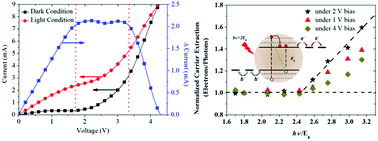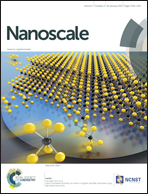Efficient charge-carrier extraction from Ag2S quantum dots prepared by the SILAR method for utilization of multiple exciton generation†
Abstract
The utilization of electron–hole pairs (EHPs) generated from multiple excitons in quantum dots (QDs) is of great interest toward efficient photovoltaic devices and other optoelectronic devices; however, extraction of charge carriers remains difficult. Herein, we extract photocharges from Ag2S QDs and investigate the dependence of the electric field on the extraction of charges from multiple exciton generation (MEG). Low toxic Ag2S QDs are directly grown on TiO2 mesoporous substrates by employing the successive ionic layer adsorption and reaction (SILAR) method. The contact between QDs is important for the initial charge separation after MEG and for the carrier transport, and the space between neighbor QDs decreases with more SILAR cycles, resulting in better charge extraction. At the optimal electric field for extraction of photocharges, the results suggest that the threshold energy (hνth) for MEG is 2.41Eg. The results reveal that Ag2S QD is a promising material for efficient extraction of charges from MEG and that QDs prepared by SILAR have an advantageous electrical contact facilitating charge separation and extraction.


 Please wait while we load your content...
Please wait while we load your content...